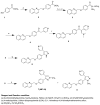Radiosynthesis and in vivo evaluation of [11C]MP-10 as a PET probe for imaging PDE10A in rodent and non-human primate brain
- PMID: 21315609
- PMCID: PMC3056285
- DOI: 10.1016/j.bmc.2011.01.032
Radiosynthesis and in vivo evaluation of [11C]MP-10 as a PET probe for imaging PDE10A in rodent and non-human primate brain
Abstract
2-((4-(1-[(11)C]Methyl-4-(pyridin-4-yl)-1H-pyrazol-3-yl)phenoxy)methyl)-quinoline (MP-10), a specific PDE10A inhibitor (IC(50)=0.18 nM with 100-fold selectivity over other PDEs), was radiosynthesized by alkylation of the desmethyl precursor with [(11)C]CH(3)I, ∼45% yield, >92% radiochemical purity, >370 GBq/μmol specific activity at end of bombardment (EOB). Evaluation in Sprague-Dawley rats revealed that [(11)C]MP-10 had highest brain accumulation in the PDE10A enriched-striatum, the 30 min striatum: cerebellum ratio reached 6.55. MicroPET studies of [(11)C]MP-10 in monkeys displayed selective uptake in striatum. However, a radiolabeled metabolite capable of penetrating the blood-brain-barrier may limit the clinical utility of [(11)C]MP-10 as a PDE10A PET tracer.
Copyright © 2011 Elsevier Ltd. All rights reserved.
Figures







References
-
- Loughney K, Snyder PB, Uher L, Rosman GJ, Ferguson K, Florio VA. Gene. 1999;234:109. - PubMed
-
- Bora RS, Gupta D, Malik R, Chachra S, Sharma P, Saini KS. Biotechnol Appl Biochem. 2008;49:129. - PubMed
-
- Hebb AL, Robertson HA. Curr Opin Pharmacol. 2007;7:86. - PubMed
-
- Coskran TM, Morton D, Menniti FS, Adamowicz WO, Kleiman RJ, Ryan AM, Strick CA, Schmidt CJ, Stephenson DT. J Histochem Cytochem. 2006;54:1205. - PubMed
Publication types
MeSH terms
Substances
Grants and funding
LinkOut - more resources
Full Text Sources
Other Literature Sources

